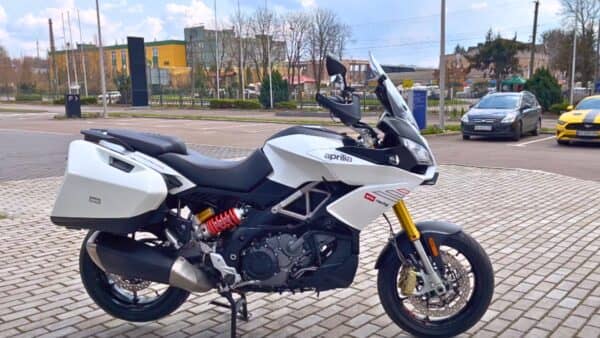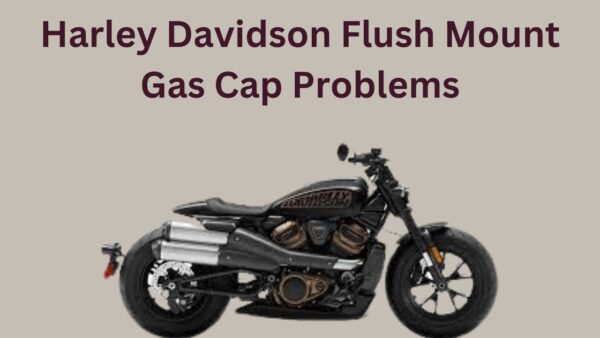The Aprilia Caponord 1200 is a stunning bike admired by many for its blend of style and performance.

However, as with any mechanical marvel, it does come with its share of problems.
Owners have reported a range of issues; which can sometimes take the shine off this otherwise fantastic motorcycle.
In this article, we’ll cover all of these common problems and provide you with a few possible solutions.
Aprilia Caponord 1200 Problems
Aprilia Caponord 1200 common problems are fuel gauge issues, exhaust valve solenoid issues, service interval timer, resetting lights errors, suspension problems, and brake and clutch problems.
1. Fuel Gauge Issue
The Aprilia Caponord 1200 sometimes exhibits a fuel gauge issue, where the indicator only shows one bar, even though the tank is full.
This problem is primarily associated with the fuel sender unit, a component designed to relay the fuel level to the gauge.
Over time, the fuel sender unit can malfunction due to wear and tear or electrical issues, causing inaccurate readings on the fuel gauge.
To resolve this problem, you should visually inspect the fuel sender unit for physical damage or signs of wear.
If the problem persists, the fuel sender unit probably needs to be replaced.
You have this done by a professional mechanic, as the process involves handling the fuel system, which can be hazardous if not done correctly.
2. Exhaust Valve Solenoid Issue
This issue is usually indicated by a grinding noise, a flashing red triangle warning, a wrench icon, and the EFI letters illuminated on the bike’s display.
The root cause of this issue can be traced back to the exhaust valve solenoid itself, which may become worn out or faulty over time due to normal wear and tear, poor maintenance, or a manufacturing defect.
Related: Aprilia RS 125 Problems
As for resolving this issue, an effective solution reported by some owners involves the replacement of the faulty solenoid with a “healer.”
A “healer” is a device that bypasses the faulty solenoid and tricks the bike’s system into thinking the solenoid is functioning correctly.
This eliminates the grinding noise and the erroneous display warnings. You can purchase a “healer” from several aftermarket suppliers.
3. Service Interval Timer
The service interval timer is designed to alert you when certain mileage or time intervals have been reached, which dictates when your motorcycle should be serviced for optimal performance.
The reasons for this indicator turning on are typically routine and based on the motorcycle’s usage.
For example, it can illuminate after a certain number of miles have been ridden or a specific amount of time has passed since the last service.
However, in some cases, it might light up due to a deviation from typical performance parameters, indicating a need for inspection.
As for solving the issue, it’s a two-step process. First, take your bike for the scheduled service.
It could involve tasks such as oil and filter change, brake inspection, tire pressure check, chain adjustment, etc.
Second, reset the service interval timer. While some users have reported being able to reset this themselves, however, you should reset the indicator after carrying out the necessary maintenance work.
4. Resetting Error Lights
These lights illuminate for various reasons, including sensor malfunctions, engine issues, or fuel system irregularities.
When these warning lights appear, you should reset them once the problem has been addressed.
Here is a step by step process:
- Firstly turn the ignition switch to the ‘On’ position.
- Find the mode button on the bike’s dashboard.
- Press and hold the mode button until you see the dashboard initiate a self-diagnostic.
- The error light should start flashing. Once the flashing ceases, release the button.
- After the light stops flashing, turn off the ignition immediately.
- Wait for about 10 to 15 seconds before starting the bike again.
This process should help reset the error lights.
5. Suspension Issues
A few causes can lead to suspension issues: worn-out suspension components due to regular wear and tear, improper alignment of the suspension setup, or lack of periodic maintenance and servicing.
To resolve these issues, you should apply several methods. Firstly, regular servicing and maintenance are crucial.
This includes checking the suspension system for any wear and tear and replacing any worn-out components as necessary.
Secondly, ensure the suspension is correctly aligned. You can do this by following the manufacturer’s guidelines or referring to the owner’s manual.
Lastly, invest in high-quality suspension components if the current ones are frequently causing problems.
6. Brake Problems
Brake problems can arise due to a variety of factors. They may stem from issues with the brake pads, brake fluid, or brake lines.
For example, worn-out brake pads can result in poor braking performance.
If the brake fluid level is low, or if the fluid is contaminated with dirt or water, it can lead to a spongy brake feel.
Moreover, damaged brake lines can impair the brake system’s functioning due to air leakage.
So, you should first inspect the brake pads. If they are excessively worn, replace them immediately.
When it comes to brake fluid, ensure it is at the right level and is clear of contaminants. If it’s low or contaminated, a brake fluid change is necessary.
For problematic brake lines, inspect them for any visible damage. In case of any leaks or cracks, replacing the brake lines should resolve the issue.
7. Clutch Problems
Aprilia Caponord 1200 owners have also occasionally reported issues with the clutch system.
A common issue is the wear and tear of the clutch plate due to frequent usage.
This can lead to a clutch slipping, which results in inconsistent power transfer from the engine to the bike’s wheels.
Another common issue is an incorrectly adjusted clutch lever, which can hinder effective gear shifting.
In order to resolve this problem you should inspect a worn clutch plate, and replace the clutch plate.
This is a task that requires some mechanical knowledge and the right set of tools, but it is feasible for someone with a basic understanding of motorcycles.
For an improperly adjusted clutch lever issue you should adjust the clutch lever to the correct tension.
You need to ensure that there’s enough free play, usually about 2-3 mm, to enable smooth shifting of gears.
Is the Aprilia Caponord Reliable?
The Aprilia Caponord is generally considered reliable with a strong track record for durability and performance.
Like any vehicle, it is not immune to occasional issues or “niggles”, but these are usually minor and can be resolved with regular maintenance and care.
Aprilia Caponord 1200 Fuel Economy
It offers an average fuel efficiency of around 18 kilometers per liter. Given the fuel tank capacity of 24 liters, this means you can expect to travel around 432 kilometers before needing to refuel under ideal conditions.
Aprilia Caponord 1200 Top Speed
The Aprilia Caponord 1200 is capable of reaching a top speed of approximately 225 km/h (140 mph).
Aprilia Caponord 1200 Technical Specifications
| Specification Category | Details |
| General Information | |
| Model | Aprilia Caponord 1200 |
| Start Year | 2016 |
| Category | Sport Touring |
| Factory Warranty | 2-year unlimited-mileage warranty |
| Dimensions, Aerodynamics, and Weight | |
| Frame Type | Single disc. ABS. Brembo single-piston caliper. |
| Wheelbase | 1,565 mm (61.6 inches) |
| Length | 2,248 mm (88.5 inches) |
| Width | 925 mm (36.4 inches) |
| Height | 1,205 mm (47.4 inches) |
| Seat Height | 840 mm (33.1 inches) |
| Front Tyres – Rims Dimensions | 120/70-17 |
| Rear Tyres – Rims Dimensions | 190/55-17 |
| Front Brakes | Double disc. ABS. Four-piston Brembo monoblock radial calipers. |
| Rear Brakes | 114.00 Nm (11.6 kgf-m or 84.1 ft. lbs) @ 6500 RPM |
| Front Brakes Dimensions | 320 mm (12.6 inches) |
| Rear Brakes Dimensions | 240 mm (9.4 inches) |
| Fuel Tank Capacity | 24.00 litres (6.34 gallons) |
| Reserve Fuel Capacity | 5.00 litres (1.32 gallons) |
| Engine and Transmission | |
| Engine Type | V2, four-stroke |
| Engine Details | Longitudinal 90° V-twin |
| Fuel System | Injection. Integrated engine management system. Injection system with triple map Ride by Wire throttle management: Sport (S), Touring (T), Rain (R) |
| Engine Size | 1197.00 ccm (73.04 cubic inches) |
| Bore x Stroke | 106.0 x 67.8 mm (4.2 x 2.7 inches) |
| Compression Ratio | 12.0:1 |
| Number of Valves per Cylinder | 4 |
| Camshaft Valvetrain Configuration | Double Overhead Cams/Twin Cam (DOHC) |
| Maximum Power | 125.00 HP (91.2 kW) @ 8250 RPM |
| Maximum Torque | 114.00 Nm (11.6 kgf-m or 84.1 ft.lbs) @ 6500 RPM |
| Cooling System | Liquid |
| Lubrication System | Wet sump |
| Gearbox | 6-speed |
| Transmission Type, Final Drive Ratio | Chain |
| Clutch Type | Multiplate wet clutch, hydraulically operated |
| Performance | |
| Emissions | Euro 3 |

Ahtsham Younas is a passionate blogger and content writer. He loves to ride motorcycles and learn the mechanical process behind the motorcycles.
He has been writing articles in the motorcycle industry since 2019 and has learned many things about motorbike niches.


